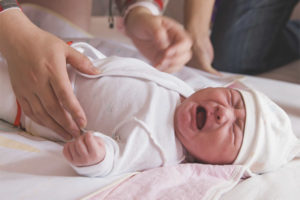The content of the article
With the arrival of autumn or spring, the small fidgets begin to actively look for puddles in the area and be sure to check their width and depth. Such checks often end with wet feet and tantrums - the mother tries to pull the baby away from the exciting activities. To solve the problem of wet feet and my mother's nerves, one way is to buy rubber boots. They do not let in moisture, they perfectly hold on to their feet, they perfectly save in wet and rainy weather. After all, slush is not a reason to refuse to walk! In addition, bright colors and prints of modern shoe models pleasantly surprise kids, they are happy to wear such boots. In this article we will talk about what children's rubber boots can be, how to choose and wear them correctly.
Types of children's rubber boots
There are several types of boots, which differ in their functionality and seasonal purpose.
- Light (summer). These are simple rubber boots that have a thin inner tab of knitwear. These boots can be worn in the summer in the rain or in early autumn, when the air temperature is still quite high.
- Demi-season. These boots are designed for autumn-spring weather, the inner tab in them is made of warm fleece, felt, fur (most often sheepskin). The legs in these boots do not freeze, the shoes are designed for deep autumn and early spring. In winter, these boots can be worn in the slush. Wearing full rubber shoes in extreme cold is not recommended, the feet may freeze. Also, you should not buy models of boots with outer fur upholstery, since it can get wet during operation and spoil the appearance of the product.
- Universal. Such a model is in demand among parents of little fidgets. The boot consists of a rubber base and a kind of felt boot, which can also be made of fleece or felt. Boots can be worn in cool weather - the legs in such shoes will not freeze. And when it becomes warm, the boot is simply removed from the boot, in the summer you can wear a boot on a thin knitted sock.
- Partially rubberized. This is a great choice for winter, severe cold and frost. Combined boots are not made entirely of rubber, but have a rubberized sole and toe. The rest of the shoe is made of boloneway waterproof fabric. However, we must remember that in too deep puddles in these boots do not go, your feet can get wet. This type of boots is suitable for children with a wide foot and high lift, as they have a side lock, velcro or lacing. In the usual rubber boots with such physical data, it is sometimes difficult to climb.
Before buying rubber boots, think about what time of year you are going to wear them. Do not forget that rubber boots are temporary shoes that can be worn only in wet weather. Wearing rubber boots constantly can not in any case.
How to choose rubber boots
To make the purchase pleasant, you need to familiarize yourself with the nuances that will help you choose a high-quality and convenient model of children's rubber boots.
It should be noted that rubber boots do not have an orthopedic insole, so they are not recommended to be worn by children under three years old, because their feet are still being formed at this time.
We say “rubber” boots, but in fact modern products rarely consist of real rubber and rubber. Such models quickly burst and crack. Much more durable, lightweight and resistant to temperature changes are the boots of PVC. Often they are cast and have only one seam - between the sole and the top of the boot. These boots will serve you no season.
Some parents think about whether it is necessary to take the boots a few sizes larger to wear them with a warm wool toe? In fact, there is no need to wear rubber boots on a thick sock, because modern models are equipped with a warm lining. But too big a shoe size will be uncomfortable for a baby, it may even fall. It is optimal to choose shoes so that the insole is 1–1.5 cm longer than the foot, but no more.
Before buying, carefully inspect the surface of rubberized shoes - it should not be damaged, scuffed, bloated, etc. The material should be uniform - without stains and white bloom.
The most important property of rubber footwear is impermeability. Check it on the store's counter is quite difficult, but the experiment must be carried out as soon as you bring the purchase home. Pack your boots with toilet paper and put your shoes in a basin of water.If rubber shoes have even the slightest hole, the paper will dampen. In this case, immediately carry the boots back to the store.
Before buying, pay attention to the condition of the sole - it must be strong, but elastic enough so that the legs easily bend it. It is better to choose models with a grooved sole, so that in wet weather the baby does not slide on smooth surfaces.
Pay attention to the material of the toe and heels of boots. These areas should be made of more dense rubber, they should be thicker. This protects the shoes from deformation, and the feet of the child from injury.
Most rubber boots are presented in models without a zipper, strings and velcro, so that the shoes do not get wet. But kids with high lift wear these boots is quite difficult. Buying rubber shoes with a zipper is also not an option - it will get wet. You can choose models in which the lacing is located in the region of the calf, this zone is rarely exposed to wetting, such a model in this case can be considered optimal.
And of course, the main choice is for the color of the boots. Children love bright and funny drawings, you can buy two pairs of boots in the same color scheme - yourself and your baby.And then the walk will be even more interesting!
How to wear rubber boots
Good immunity is not only charging, hardening and vitamins. It is also a frequent walk in any weather. Fortunately, there are different raincoats on sale, interesting umbrellas and favorite rubber boots, so that nothing would darken the fun on a rainy day!
Video: how to choose boots for a child











To send